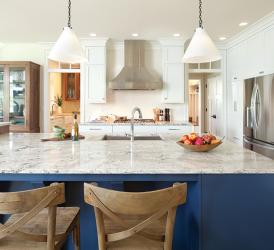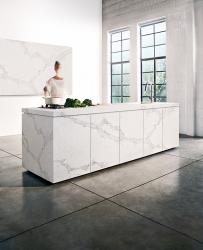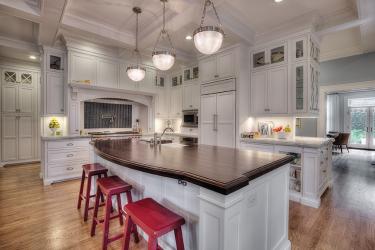Whether you’re building a new kitchen or remodeling the one you’ve got, choosing a countertop is a big – and expensive – decision. National Kitchen & Bath designer Ashleigh Schroeder weighs in on the pros and cons of five popular surface materials for your home’s busiest space.
Granite
Granite is popular for a reason: You’d be hard pressed to cut, burn or scratch it, and polished and matte finishes are typically stain resistant, too, when properly sealed. While annual upkeep is a downside for some homeowners, Schroeder says, “Don’t let this be the thing that deters you.” Spray-on sealers are available, and some fabricators offer a 10-year seal. On a budget? Schroeder recommends category “A” colors. “With granite categories,” she says, “It’s not about quality.” Pricing is based on whether a rock specimen is readily available in nature; rare colors and veining cost more, and exotic slabs might be fragile, with naturally occurring fissures that could rupture during installation.
Quartz
Rivaling granite as today’s top high-end countertop, quartz offers consumers a lot of bang for their buck. The manmade substance mimics the stunning look of natural stone and requires minimal maintenance. “It’s easy to clean, and it won’t cut, stain or scratch,” says Schroeder, noting that, technically, homeowners can chop directly on quartz counters. (Schroeder recommends a cutting board.) “There aren’t really any cons to quartz,” she continues, lauding the material as design-friendly, too, because it’s available in a range of colors and patterns that jive with most schemes. Quartz companies, Schroeder adds, are skilled at replicating the white marble look that’s trending. But, she adds, “If you want that big, sweeping look of natural granite, you’ll need to go with granite.”
Marble
There’s no denying that designer darlings such as Carrara and Calacatta are aesthetically pleasing, with the elegant, gray-toned veining modern consumers covet. “Marble is fine for the bathroom,” Schroeder says, adding, “But it’s not a good idea in the kitchen.” The expensive material is soft, leaving it vulnerable to stains, etches, and chips – the latter of which can be problematic during installation. Marble requires special cleaning products, too, and yearly sealing. “After a relatively short time, marble can look like it is a hundred years old,” Schroeder adds, counseling clients who want the grand look of marble to consider quartz, with one small caveat: “Marble is good for baking because it’s cold and nice for rolling dough,” says Schroeder. Can’t live without marble in your kitchen? Use it on an island, or a section of an island.
Soapstone
This natural stone is beautiful and superb at resisting heat damage and bacteria. Homeowners, though, should be prepared for upfront maintenance. Soapstone is delivered in its natural state; if you don’t oil it regularly, every splash and touch will leave its mark; over time – especially around countertop edges. Oily buildup can permanently alter soapstone counters. “Oiling darkens the soapstone, and eventually it will become seasoned so you’ll only have to oil it once a year to maintain the rich color,” Schroeder explains. Homeowners who are after that “vintage, Old English look,” as Schroeder puts it, often find that few materials compete with soapstone.
Wood
Decorative, functional and easy to install, wood surfaces are gaining traction in contemporary kitchens. “It’s a beautiful look,” Schroeder says, noting that wood offers “something different for the eye.” Keep in mind, though, that wood is going to scratch. “You have to be okay with that,” Schroeder says. Wood counters make cooking a breeze. Properly sealed, they’re sanitary, even for chopping meat. “Cut directly on wood, clean it with soap and water, and remember to oil your prep areas,” Schroeder advises. Similar to marble, Schroeder often recommends wood counters in small doses: “Use quartz for your main counter spaces, and incorporate a small raised section that’s wood,” Schroeder recommends.
With all the beautiful styles and options at your fingertips, it can be hard to decide on just one. Mixing and matching surfaces is an option to get the best of both worlds.
Resources
http://www.nationalkitchenandbath.comNational Kitchen & Bath, 314-962-1800









